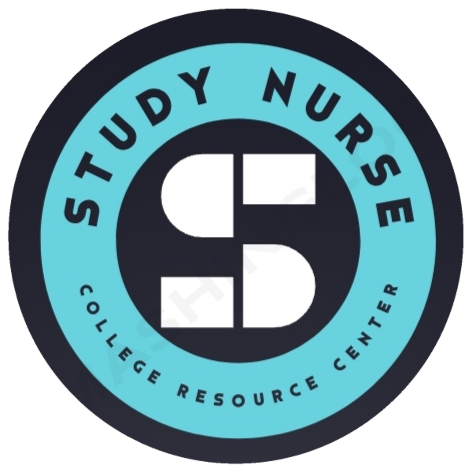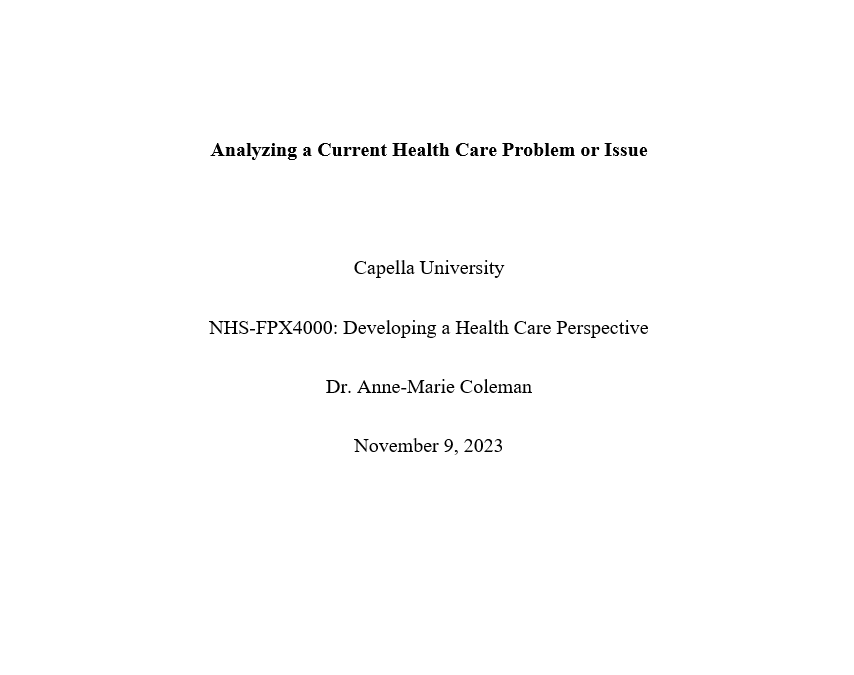Capella University
NHS-FPX4000: Developing a Health Care Perspective
Dr. Anne-Marie Coleman
November 9, 2023
Analyzing a Current Health Care Problem or Issue
Medication errors are preventable issues that expose an organization to adverse consequences such as increased risk of readmissions, prolonged hospitalization, and additional costs of care. Adverse drug reactions raise questions about the level of safety and commitment to enhancing a patient’s recovery from various conditions. Further, a facility risks losing credibility due to reputational losses associated with medication errors. In this context, healthcare leaders should initiate proactive solutions to enhance quality and safety of patient care across the continuum.
Medication Errors
Medication errors are common in a critical setting where nurses and physicians handle complex situations. Such environments make individuals vulnerable to distractions, burnout, ineffective information flows, and others issues that jeopardize the quality of dispensing and administering medications (Alghamdi et al., 2019). The common causes of errors are dose miscalculations, incorrect diagnosis, prescribing errors, failed communication, and inadequate staff and patient education. The errors remind health leader and the care team about the need for proper procedures, processes, and systems. The goal is to address issues such as poor handwriting, missing information, wrong labeling and transmission of drug names, and prescription errors (Alrabadi et al., 2021). For this assessment, the focus is on wrong drug administration, which triggers an adverse drug reaction, severe complications, and premature deaths.
A case study on wrong drug administration involves a nurse’s negligence at Vanderbilt University Medical Center that led to a patient receiving a powerful paralyzer, vecuronium instead of the recommended sedative, versed (Clark, 2022). The nurse claimed that she accidentally confused the drugs leading to the unfortunate patient’s death. Investigations revealed that the nurse overrode instructions on drawing medication from an electronic cabinet. The process led to the nurse confusing the letters of drug names, hence selecting the wrong medication, administering, and causing a patient’s death.
Analysis
Most medication errors are preventable since they largely reveal gaps in administrative, technical, and human-related safeguards. One cause of errors is nurse negligence, where one may ignore procedures, standards, and processes in place to enhance quality and safety of patient care (D’Errico et al., 2022). The neglect also entails distractions in unrelated tasks and conversations, failure to read instructions, and failure to consult in case of an issue. Secondly, weak supervision and oversight also increase the risk of wrong administration of high-risk medications (Alghamdi et al., 2019). Thus, wrong administration errors raise questions about robustness of policies, structures, and safety culture across the care continuum. The errors also show ethical concerns involving nurses’ non-adherence to the principles of non-maleficence, beneficence, and justice. Increased vigilance is necessary to reduce the risks of readmissions, prolonged hospitalization, deaths, and additional costs associated with adverse drug reactions.
Considering Options
Organizations have several options available to identify and intercept risks and errors across the care continuum. One strategy is creating barriers that enhance oversight and supervision when accessing high-risk medications. The solution prevents or delays access to sensitive drugs such as vecuronium (Clark, 2022). For instance, an obtrusive label clarifying a drug is paralytic helps prevent confusion when handling medications with similar initials. A second intervention is policies clarifying the importance of oversight and verification by a qualified practitioner before administering medications. The move ensures that patients received the right dosage and drug at the right timing. A robust safety culture is importance to overcome normalization of mistakes and deviance that undermine a patient’s health and well-being (D’Errico et al., 2022). The right culture encourages nurses, physicians, and clinical assistants to find workarounds and provide timely updates on evidence-based interventions. Training and education is also necessary to remind the staff about the consequences of overriding safety measures during dispensation and administration of medications. Further, advancements in health technologies makes barcoding a necessary aspect of safety enhancement practices. The technology promotes accurate verification of medications, the patient, timing, dosage, and route. The goal is to ensure nurses adhere to the rights of medication administration across the care continuum.
Solution
Wrong medication administration reveals the need for increased vigilance, accountability, and responsibility when administering medications. Barcoding is the preferred solution because it reminds nurses to scan a code of a patient, drug, and other details to match the physician’s order correctly (D’Ericco et al., 2022). The goal is to reduce the number and frequency of errors in drug administration, resulting in fewer readmissions, hospitalizations, costs, and deaths. In this case, scanning a patient’s wristband makes nurses alert and responsive when there is a medication mismatch. Further, automated alerts promotes immediate updating of records to ensure the patient receives the correct medication (Cetin & Cebeci, 2021). The solution aligns with calls for hospitals to modernize health services by integrating systems and streamlining efficiency. Thus, barcoding is a viable option for the care team to uphold personal and professional responsibility and accountability when administering high-risk medications.
Ethical Implications
Adopting barcode medication administration reminds nurses about their obligation towards upholding beneficence, non-maleficence, and justice principles. A crucial consideration is acting in the best interests of a patient by avoiding distractions, miscommunications, and negligence associated with medication errors (Cetin & Cebeci, 2021). Similarly, the care team becomes familiar with the non-maleficence principle and the need for actions that protect patients from emotional, physical, financial, and psychological distress. In this context, nurses learn to exercise moral awareness, judgment, and ethical behavior when preparing and administering medications (Vaismoradi et al., 2021). Further, barcode medication administration clarifies the importance of justice in ensuring that patients receive the best care. The tool encourages nurses to pay attention to the five rights of medication administration and reduce the risk of severe complications and additional costs. The emphasis is on consistent adherence to personal and professional duty of care across the care continuum.
Implementation
Implementing barcode medication administration largely depends on the ability to acquire advanced and functional software and hardware components. The aim is to integrate the system to EHRs and other networks designed to optimize care outcomes. The implementation process also involves comprehensive training and education to enhance the workforce’s ability to match patients with their medications correctly. The move reduces the risk of human errors by making nurses competent in what they do across the care continuum. Financially, the organization can incur about $8,400 for the implementation, with a projected return on investment of around $600,000 every year.
Conclusion
The adverse health, cost, and reputational impact of medication errors reveal the need for viable and sustainable measures. Evidence-based solutions help an organization overcome challenges of burnout, distractions, miscommunication, negligence, and technological gaps in medication preparation, dispensation, and administration. Barcoding is a feasible solution that enhance the accuracy of medication administration through verification of a patient details, medication type, timing, route, and dosage.
References
Alghamdi, A., Keers, R., Sutherland, A., & Ashcroft, A. (2019). Prevalence and nature of medication errors and preventable adverse drug events in pediatric and neonatal intensive care settings: A systematic review. Drug Safety, 42, 1423-1436. https://link.springer.com/content/pdf/10.1007/s40264-019-00856-9.pdf
Alrabadi, N., Shawagfeh, S., Haddad, R., Mukattash, T., Abuhammad, S., Al-rabadi, D., Farha, R., AlRabadi, S., & Al-Faouri, I. (2021). Medication errors: A focus on nursing practice. Journal of Pharmaceutical Health Services Research, 12, 78-85.
Çetin, S & Cebeci, F. (2021). Perceptions of clinical nurses about the causes of medication administration errors: A cross-sectional study. Florence Nightingale Journal of Nursing, 29(1), 56-64. https://www.ncbi.nlm.nih.gov/pmc/articles/PMC8137725/
Clark, C. (2022, June 2). Anesthesiologist group says hospitals can prevent fatal errors like Vanderbilt’s. MedPage. https://www.medpagetoday.com/special-reports/exclusives/99021
D’Errico, S., Zanon, M., Radaelli, D., Padovano, M., Santurro, A., Scopetti, M., & Frati, P. (2022). Medication errors in pediatrics: Proposals to improve the quality and safety of care through clinical risk management. Frontiers in Medicine, 8, 1-6. https://www.frontiersin.org/articles/10.3389/fmed.2021.814100/full
Vaismoradi, M., Moe, C.F., Vizcaya-Moreno, F., & Paal, P. (2021). Ethical tenets of PRN medicines management in healthcare settings: A clinical perspective. Pharmacy, 9(4), 1-10. https://www.ncbi.nlm.nih.gov/pmc/articles/PMC8552074/pdf/pharmacy-09-00174.pdf

